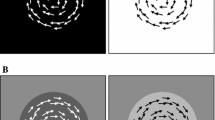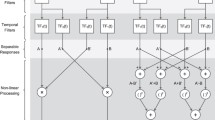Summary
(1) It has been shown in earlier experiments that during the visually guided orientation response of the mealworm beetle,Tenebrio molitor, edge fixation and skototaxis interact. Under certain stimulus conditions these two effects act against each other and relative movement between the retina and the surroundings shifts the balance in favour of edge fixation. In this paper, three further parameters are described which change the contribution of the two mechanisms to the turning tendency of the animals. (2) When the centre of a broad black stripe lies on one side and one of the edges on the other side of the animal (Fig. 1B, C) then motion of an edge from front to back (progressive movement) more effectively increases the relative weight of edge fixation than do regressive movements (motion of an edge from back to front). (3) In the same situation temporal modulation of the overall illumination weakens skototaxis, dimming more than brightening (Fig. 2 A). From this it was predicted — and confirmed — that the dependence on the direction of motion will be reversed if both the centre and the edge closest to the midline of a broad black stripe lie on the same side of the animal (Fig. 2 B). (4) Animals with one eye blinded can fixate an edge (Fig. 3). Furthermore, edge fixation is mediated mainly by the ventral part of the eyes and skototaxis by the dorsal (Fig. 5). (5) The possible significance of the results for the animal's natural behaviour and for the underlying neural circuitry is discussed.
Similar content being viewed by others
References
Götz KG, Gambke C (1968) Zum Bewegungssehen des MehlkäfersTenebrio molitor. Kybernetik 4:225–228
Junger W, Dahmen HJ (1986) Visuell ausgelöstes Verhalten zur Kompensation von Verdriftung bei Wasserläufern. Verh Dtsch Zool Ges 79:217
Kunze P (1963) Der Einfluss der Größe bewegter Felder auf den optokinetischen Augenstielnystagmus der Winkerkrabbe. Erg Biol 26:55–62
Kunze P (1964) Eye-stalk reactions of the Ghost CrabOcypode. In: Reiss RF (ed) Neural theory and modeling. University Press, Standford, pp 293–303
Mast SO (1923) Photic orientation in insects, with special reference to the drone-fly,Eristalis tenax, and the robber fly,Erax rufifarbis. J Exp Zool 38:109–205
Nalbach HO, Nalbach G (1987) Distribution of optokinetic sensitivity over the eye of crabs: its relation to habitat and possible role in flow-field analysis. J Comp Physiol A 160:127–135
Pick B (1974) Visual flicker induces orientation behaviour in the flyMusca. Z Naturforschg 29 c:310–312
Preiss R, Kramer E (1984) The interaction of edge fixation and negative phototaxis in the orientation of walking gypsy moths,Lymantria dispar. J Comp Physiol A 154:493–498
Reichardt W (1973) Musterinduzierte Flugorientierung. Verhaltensversuche an der FliegeMusca domestica. Naturwissenschaften 60:122–138
Sandeman DC (1978) Regionalization in the eye of the crabLeptograpsus variegatus: Eye movements evoked by a target moving in different parts of the visual field. J Comp Physiol 123:299–306
Sokoloff A (1974) The biology ofTribolium. I–III. Clarendon Press, Oxford
Strebel J (1982) Eigenschaften der visuell induzierten Drehmomenten-Reaktionen von fixiert fliegenden StubenfliegenMusca domestica L. undFannia canicularis L. Dissertation, Universität Tübingen
Varjú D (1976) Visual edge fixation and negative phototaxis in the mealworm beetleTenebrio molitor. Biol Cybern 25:17–26
Varjú D, Bolz J (1980) Head movements of the mealworm beetleTenebrio molitor. I. Their properties in stationary environments and their role during object fixation. Biol Cybern 36:109–115
Wehrhahn C (1984) Visual orientation of flies in flight. In: Varjú D, Schnitzler U (eds) Localization and orientation in biology and engineering. Springer, Berlin Heidelberg New York, pp 112–118
Zeil J (1983) Sexual dimorphism in the visual system: The free flight behaviour of male Bibionidae (Diptera). J Comp Physiol 150:395–412
Author information
Authors and Affiliations
Rights and permissions
About this article
Cite this article
Varjú, D. The interaction between visual edge fixation and skototaxis in the mealworm beetle Tenebrio molitor. J. Comp. Physiol. 160, 543–551 (1987). https://doi.org/10.1007/BF00615088
Accepted:
Issue Date:
DOI: https://doi.org/10.1007/BF00615088




